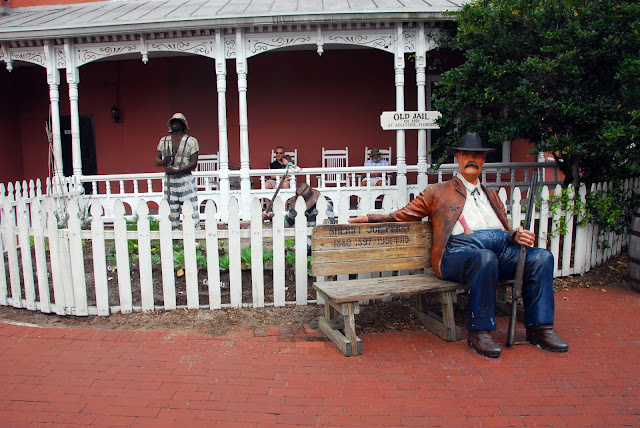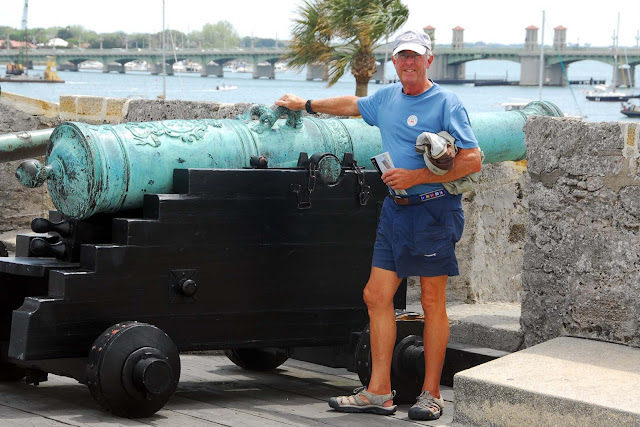. . . FROM BEAUTIFUL CUMBERLAND ISLAND TO THE MARSHES OF GLYNN

Carina left Florida's waters on Thursday, motor-sailing to Cumberland Island, Georgia. We arrived Thursday night anchoring between the big island and a tidal mud island. The eight-foot tide was the largest we'd ever seen, revealing broad mud flats.
North of Fernandina Beach, we heard a boat named Say Good-bye radioing others. How many boats could there be named Say Good-bye? We'd met Ralph and Celeste on their boat north of Columbus, Mississippi, traveling down the Tennessee-Tombigbee Waterway. They stopped in Florida for several months, and we stopped for several months. In one of those "it's a small world" moments, our paths crossed again, and they joined us at the Cumberland Island anchorage.
Georgia Currents and Winds
Friday morning, we woke early to find that the current was flowing in one direction and the wind blowing in the exact opposite. That had caused the boat to spin and our anchor rode (the line that connects the anchor to the boat) to go beneath Carina, hooking on her wing keel. The danger was that the intense pressure on the rode would cause us to drag anchor, possibly into the mud flat shallows.After several anxious moments, we were able to work the anchor rode free of the keel by starting the engine and turning Carina, first left, then right, when it loosened. We then took the dinghy to the island for a tour as though nothing out of the ordinary had happened.
Carina after her anchor problem was cleared up, seen from Cumberland Island.
Beautiful, Wild, Historical Cumberland Island
Everything good you may have heard about Cumberland Island is true. It is stunning, is overflowing with wildlife, and steeped in history.
More than half the island looks like this -- palmettos, spreading live oaks
and Spanish moss.
and Spanish moss.
Thanks to recent rain, the dead-looking Resurrection fern re-hydrated and is now
flourishing. The fern can be found on most live oaks on the island.
Tall dunes were at the entrance to the National Seashore itself on the Atlantic
side of the island.
side of the island.
The Cumberland Island National Seashore is 17 miles of pristine beach.
Most of the island is managed by the National Park Service, and access is limited.
Although we've been on the lookout for alligators because we're traveling
with Gator Bait (Squirt), this one is the first we've seen, floating in a pond
filled with duck weed on Cumberland Island.
with Gator Bait (Squirt), this one is the first we've seen, floating in a pond
filled with duck weed on Cumberland Island.
This nesting wood stork on Cumberland Island is part of an endangered breeding
population. The wood stork is the only stork to breed in North America.
It seemed odd for our tour guide to use the term "feral" to describe the wild horses
on the island. It turns out that a feral horse is a free-roaming horse of domesticated
ancestry. About 150 feral horses roam the island.
This tiny church, holding about two dozen people, is where John F. Kennedy, Jr., and Carolyn Bessette were married. He had helped restore the First African Baptist Church in his youth and said that he wanted to be married there.
The pulpit and the rest of the inside of the church were simple and unadorned.
It made us see John Kennedy, Jr., in a new light.
The history of Cumberland Island is intertwined with the names of millionaires of the late 1800s-early 1900s -- the Carnegies who lived there and the Rockefellars who sought to protect the island. We ran out of time to visit the ruins of Dungeness, the Thomas Carnegie home, but were able to tour the Plum Orchard mansion, owned by one of their children. Lucy Carnegie gave her son, George, and new bride $10,000 for a wedding present in 1898. With the money, they built the main part of their winter home, adding the wings two years later. $10,000 went a lot farther then than now.
Plum Orchard features ornate capitals and cornices. The mansion has 117 rooms in 21,700 square feet, including the attic and basement. It has an indoor pool and indoor squash court.
Inside the entrance was a hanging lamp personally designed and fabricated
by Louis Tiffany, a friend of the Carnegie family.
The most valuable lamps were a set of two hanging lamps in one of the many living areas. Louis Tiffany designed them to look like the backs of loggerhead turtles. Cumberland Island is one of the breeding areas for the endangered turtles.
The Marshes of Glynn
Although the trawler looks aground, it's in the channel, just on a different
loop than Carina was.
In Marathon, we'd laughed at the name of a boat -- Always Something. There is truly always something that breaks or needs to be improved on a boat. We discovered our latest "something" was a broken water pump and -- thanks to our friend, Stan -- ordered a new one from the Catalina dealer at the marina. On Sunday, Kent had switched the pump out in a matter of minutes, and we did boat chores the rest of the time.
The barnacles are up some eight feet above the
waterline on the pole next to Carina. That shows how high the tides get.
Another view of the mud flats and salt marshes with the tide mostly out
and the fog mostly in.
and the fog mostly in.
It seemed odd that the Brunswick area would have a huge bridge -- 182-feet tall -- honoring the poet Sidney Lanier who lived most of his life elsewhere. Then we found that the county is named Glynn. Add the salt marshes to that mix, and we came to understand the good folk honored him because he honored them with his poem, The Marshes of Glynn. Here's a bit:
Oh, what is abroad in the marsh and the terminal sea?
Somehow my soul seems suddenly free
From the weighing of fate and the sad discussion of sin,
By the length and the breadth and the sweep of the marshes of Glynn.
This morning we left the marshes of Glynn behind in a lifting fog to travel north again, this time to the marshes of McIntosh (County). There, Marathon friends Hamp and Denise on Gracie are waiting for us at Darien, Georgia.























































